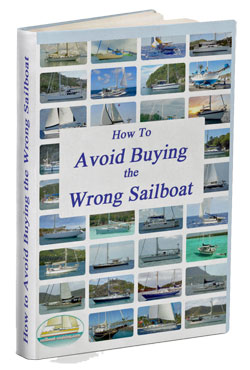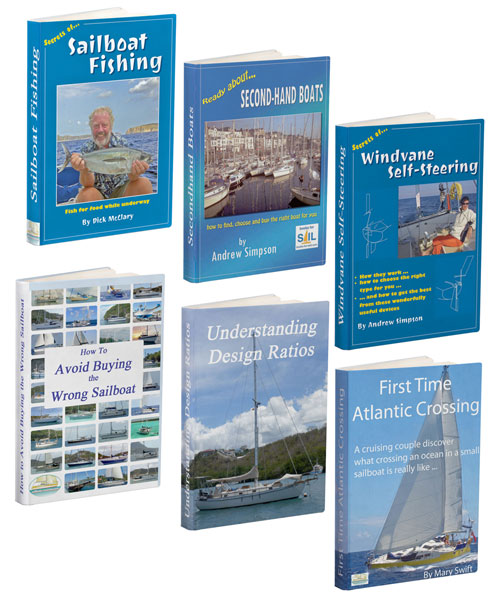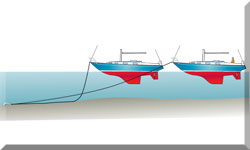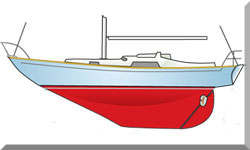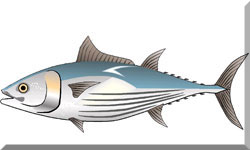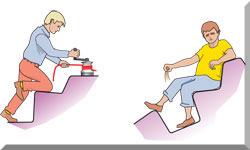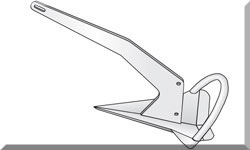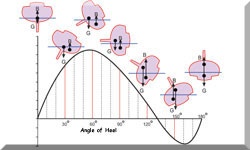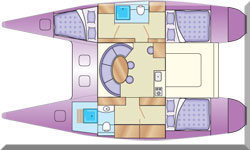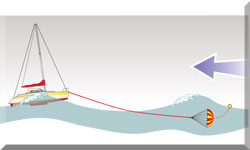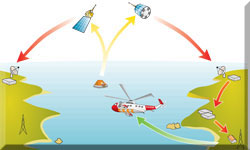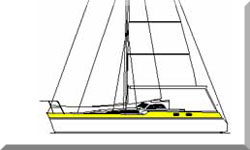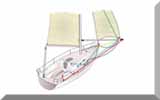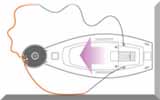- Home
- Cruising Yachts 30' to 35'
- Pearson 303
The Pearson 303 Sailboat
Specs & Key Performance Indicators
The Pearson 303, a heavy-displacement masthead sloop, was designed by William Shaw and built in the USA by Pearson Yachts.
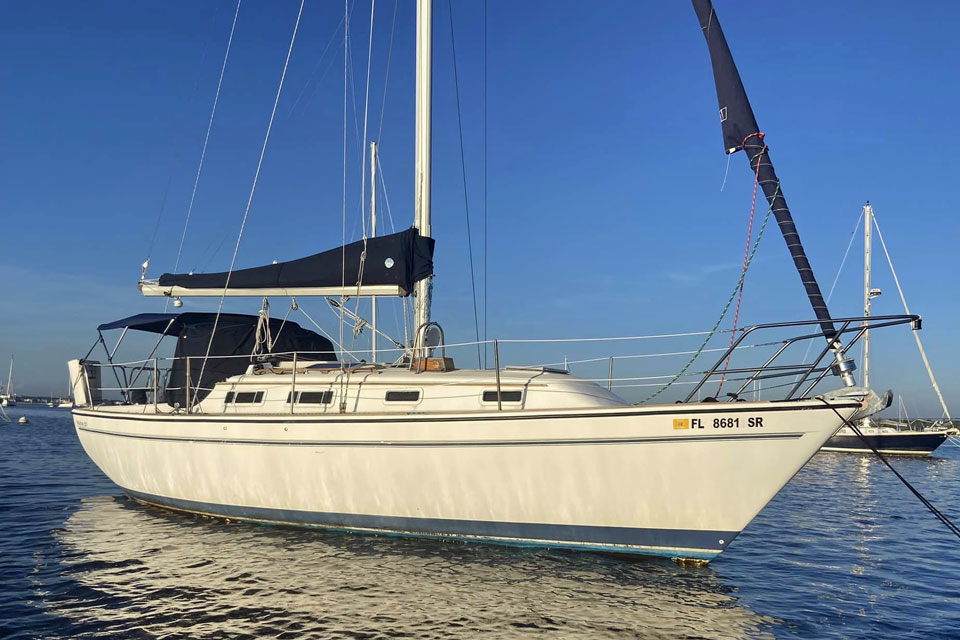 The Pearson 303
The Pearson 303Published Specification for the Pearson 303
Underwater Profile: Fin keel & skeg-hung rudder
Hull Material: GRP (Fibreglass)
Length Overall: 30'4" (9.2m)
Waterline Length: 23'4" (7.7m)
Beam: 10'11" (3.3m)
Draft: 4'4" (1.3m)
Rig Type: Masthead sloop
Displacement: 10,100lb (4,581kg)
Ballast: 3,500b (1,588kg)
Designer: William Shaw
Builder: Pearson Yachts (USA)
Year First Built: 1983
Year Last Built: 1986
Published Design Ratios for the Pearson 303
1. Sail Area/Displacement Ratio: 15.8
2. Ballast/Displacement Ratio: 34.7
3. Displacement/Length Ratio: 276
4. Comfort Ratio: 24.1
5. Capsize Screening Formula: 2.1
Summary Analysis of the Design Ratios for the Pearson 303
1. A Sail Area/Displacement Ratio of 15.8 suggests that the Pearson 303 is slightly underpowered and will need a stiffish breeze to get her going. In light conditions, unless you've got plenty of time on your hands, motor-sailing may be the way to go.
2. A Ballast/Displacement Ratio of 34.7 means that a sailboat like the Pearson 303 (which doesn't have a stiffness-enhancing bulb keel), is likely to benefit from being reefed early to keep her sailing upright in a moderate breeze.
3. A Displacement/Length Ratio of 276 tells us that the Pearson 303 just creeps into the heavy displacement category. You can load her down with all your cruising gear and equipment and it will hardly affect her waterline. A steady and robust choice for coastal sailing, but she'll come into her own on an offshore passage in testing conditions.
4. Ted Brewer's Comfort Ratio of 24.1 suggests that crew comfort of a Pearson 303 in a seaway is similar to what you would associate with the motion of a coastal cruiser with moderate stability, which is not the best of news for anyone prone to seasickness.
5. The Capsize Screening Formula of 2.1 tells us that a Pearson 303 would not be as good a choice of sailboat for ocean passage-making, owing to the increased risk of capsize in strong winds and heavy seas when compared to a sailboat with a CSF of less than 2.0.
Any Questions?
What other versions of the Pearson 303 were built?
What other versions of the Pearson 303 were built?
The Pearson 303 was not built in different versions, but it was a successor to the popular Pearson 30, which had a similar hull shape but a different rig and interior layout. The Pearson 303 was replaced by the Pearson 31, which had a longer waterline and more sail area.
What is the accommodation like in the Pearson 303?
What is the accommodation like in the Pearson 303?
The Pearson 303 has a spacious and comfortable interior for a 30-foot boat. It can sleep up to six people in two cabins and the saloon. The forward cabin has a large V-berth and a bureau, the saloon has two settees that can be used as berths, and the aft cabin has a quarter berth that can also serve as a navigation station. The head compartment is located to starboard, opposite the galley, which has a two-burner stove, a sink, and a large icebox.
What is the Pearson 303 like to sail?
What is the Pearson 303 like to sail?
The Pearson 303 is an easy and stable boat to sail, with moderate performance and good handling. It is not very fast or agile, but it can handle various wind and sea conditions well. It tracks well downwind thanks to its skeg, and it does not heel excessively thanks to its beam. It is suitable for coastal cruising and occasional offshore passages.
What is the average cost of a secondhand Pearson 303?
What is the average cost of a secondhand Pearson 303?
The average cost of a secondhand Pearson 303 depends on the condition, equipment, and location of the boat. According to some online listings, the price range can be from $20,000 to $40,000 USD.
Is this boatbuilder still in business?
Is this boatbuilder still in business?
No, Pearson Yachts ceased production in 1991 after being sold to Aqua Buoy Corporation. The company had been in business since 1959 and had built over 10,000 boats of various models and sizes.
What other sailboats have been created by this designer?
What other sailboats have been created by this designer?
William Shaw was the chief designer of Pearson Yachts from 1964 to 1991. He designed many successful sailboats for the company, such as the Pearson Triton, the Pearson Ensign, the Pearson Vanguard, the Pearson Ariel, the Pearson Flyer, the Pearson Renegade, the Pearson Wanderer, the Pearson Coaster, the Pearson Countess, the Pearson Invicta, the Pearson Alberg 35, the Pearson Rhodes 41, the Pearson Ariel II, the Pearson Commander II, the Pearson Electra II, the Pearson Triton II, the Pearson Vanguard II ...
What is the history of Pearson Yachts?
What is the history of Pearson Yachts?
The history of Pearson Yachts is a story of innovation, success, and decline in the sailboat industry. Here are some key points:
- Pearson Yachts was founded by cousins Everett and Clinton Pearson in 1956, who started building fibreglass dinghies in their garage in Seekonk, Massachusetts. They were among the first fibreglass sailboat manufacturers in the world;
- In 1959, they launched the Triton 28, a fibreglass auxiliary sailboat designed by Carl Alberg, at the New York Boat Show. The boat was a hit and they received 17 orders by the end of the show. They moved their production to Bristol, Rhode Island, and introduced more models, mostly designed by Alberg;
- In 1961, they sold a controlling interest to Grumman Allied Industries, a large aerospace and defence company. Bill Shaw became the chief designer when the Pearson cousins left the company in the 1960s. He created many successful boats for Pearson, such as the Pearson 40, the Pearson 424, and the Pearson 303;
- In the 1980s, Pearson faced financial difficulties and changed ownership several times. In 1991, they filed for bankruptcy and ceased production. The rights to the name were acquired by TPI Composites, which later became Pearson Marine Group.
The above answers were drafted by sailboat-cruising.com using GPT-4 (OpenAI’s large-scale language-generation model) as a research assistant to develop source material; to the best of our knowledge, we believe them to be accurate.
Recent Articles
-
Modern Boat Electronics and the Latest Marine Instruments
Dec 20, 25 05:27 PM
Should sailboat instruments be linked to the latest boat electronics as a fully integrated system, or is it best to leave them as independent units? -
Hans Christian 43: Classic Bluewater Cruiser & Liveaboard Sailboat
Dec 10, 25 04:37 AM
Explore the Hans Christian 43: a legendary heavy-displacement, long-keel sailboat. Read our in-depth review of its specs, design ratios, and suitability for offshore cruising and living aboard. -
Planning Your Sailboat Liveaboard Lifestyle: An Ocean Sailor's Guide
Dec 06, 25 05:18 AM
Seasoned sailors share their methodical risk analysis for planning a secure Sailboat Liveaboard Lifestyle, covering financial, property, and relationship risks.
